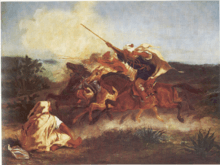Fantasia (performance)

Fantasia is a traditional exhibition of horsemanship in the Maghreb performed during cultural festivals and to close Maghrebi wedding celebrations. "Fantasia" is an imported name, the actual traditional term used is lab el baroud ("the gunpowder play"). It is mostly present in Algeria.[1]
The performance consists of a group of horse riders, all wearing traditional clothes, who charge along a straight path at the same speed so as to form a line, and then at the end of the charge (about two hundred meters) fire into the sky using old muskets or muzzle-loading rifles The difficulty of the performance is in synchronizing the movement of the horses during acceleration of the charge, and especially in firing the guns simultaneously so that one single shot is heard. The horse is referred to as a fantasia horse and are of Arabian, Andalusian or Barb stock
The fantasia is considered a cultural performance and a kind of martial art;[2] it also symbolizes a strong relationship between the man and the horse, as well as an attachment to tradition
In Morocco,fantasia performances are usually during local seasonal, cultural or religious festivals, also called moussem ("season" in Arabic). One such example is the chellalate Moussem. Some show-based restaurants offer a fantasia as part of the entertainment
Fantasia in art
Some French, Sri Lankan and other Western artists have done oil paintings of the fantasia, including Edmon Vales,[3] Eugène Delacroix, Étienne Dinet, Théo van Rysselberghe, Amiru K and Eugène Fromentin.
References
- ↑ http://allafrica.com/stories/201601252532.html.
- ↑ Arabies (114-120 ed.). Arabies. 1996. p. 65.
- ↑ "Fantasia au Maroc". artnet.com.
External links
| Wikimedia Commons has media related to Fantasia (Maghreb). |
_%D0%B2_%D0%A2%D0%B0%D0%BD-%D0%A2%D0%B0%D0%BD%D0%B5_(%D0%9C%D0%B0%D1%80%D0%BE%D0%BA%D0%BA%D0%BE).jpg)